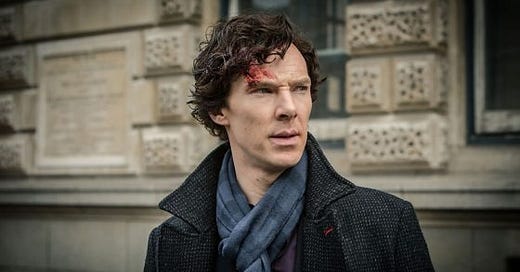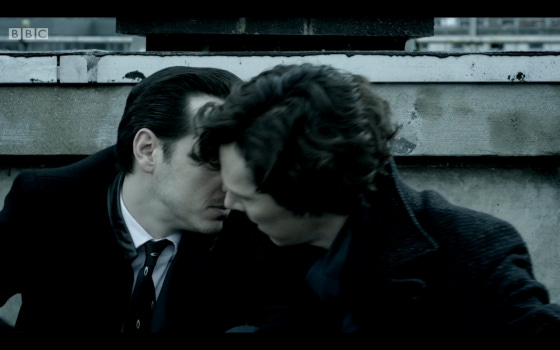Written by Prof. Jenn
As a reminder: I am writing these as RETROSPECTIVE reviews, so I will be discussing reveals, resolutions of cliffhangers, ends of plots, etc. If you are reading these reviews without having seen the eps, a) what is wrong with you?? Go watch them now! and b) these reviews are not for you till you’ve seen them.
NOTE: as per uzh, I wrote this originally for Sherlock’s Home, which is a UK-based site. My spelling and etc. will reflect that. Usually. Ahem. This retro-review appeared there in June of 2016, and has been slightly altered since.
It’s rare that the makers of a TV series have such intense interactions with their fanbase, and also unusual to find shows with the level of rabid fans that Sherlock boasts. From erotic fanfiction to conspiracy theories to #setlock on Twitter and Tumblr, the fans of this show have their own ways they want things to go, and will spare no word count (or technology) to express it. This can be positive, as is seen to an extent in this episode, because the fans feel a part of the creative process of making the thing (more than being mere passive spoon-fed consumers). It can also be negative, as invasive requests of fanfic readings and disruptive #setlock fans make for roadblocks in the very making of the thing they love. I mean, Moffat felt the need to quit Twitter because of it.
After the end of ‘The Reichenbach Fall’, the theories abounded as to how Sherlock managed to stage his death so convincingly. YouTube was rife with lectures accompanied by freeze frames, attempting to pinpoint the physical setup, and the screenplay was analysed minutely to attempt to find a vestige of a clue. Anderson, in ‘The Empty Hearse’, is a character who embodies the Crazed Sherlock Uber-Fan that happened globally irl, and in the most meta of moves on the part of Mark Gatiss (this ep’s writer), forms a fan club of others of his same ilk. What Gatiss does so brilliantly here, is begins the episode with a behind-the-scenes detailed look at The Fall, then pulls the rug out from under us, revealing it’s actually Anderson’s latest fan theory of how Sherlock did it.
We get a couple more scenes like this throughout: one by a club member which is abruptly interrupted before it turns into a piece of fanfic erotica, and then one at the very end, by Sherlock himself. These conspiracy theories are both an homage to the fans and a mocking of them, but what’s even better is that we never actually find out the details of the real story. We think that Sherlock has told Anderson the truth at the end of the ep, but then, like Anderson himself, we realize that there’s no way that could be the case. Which is perfect, because any ‘real’ story Mofftiss could have concocted wouldn’t be nearly good enough for its fans, after all the incredible hype leading up to it. Which reminds me:
I mentioned in my ‘Reichenbach’ review that I felt Moriarty’s elaborate scheme didn’t really make a whole lot of sense. But after watching that one, and especially seeing the in-between short ‘Many Happy Returns’, I was excited to see, not so much the How Sherlock Lived bit, but the How Moriarty Is Defeated concept instead. Remember, not only has Sherlock’s reputation been indelibly ruined, but the echoes of IOU rebound in Moriarty’s suicide. I was ready to find out how the public would react to Sherlock’s return, how the whole Richard Brook conspiracy would be brought to light, and what on earth IOU was all about.
I was disappointed.
All we get is a brief montage of TV news stories, boiling down to: yep, Moriarty was real; nope, Sherlock wasn’t to blame; too bad we all figured this out now he’s dead, but anyway, on to the weather…
Where’s Kitty Riley? Where’s Sgt. Donovan? What the heck was IOU all about? If the snipers were hired to kill Sherlock’s friends with or without Moriarty, whatever happened to them? Poof, into thin air? Everybody’s fine now, and Moriarty is dead?His deep, complex, well-constructed takedown of Sherlock is just….whoopsied away?*

It feels to me as though the explanation of all that complex plot buildup was rushed in order to make room for all the fan service theories and for the reappearance of Sherlock to his old friends. Albeit it’s a well-done return: in the original Conan Doyle story (‘The Adventure of the Empty House’), Watson just says, Sure I’m back in the game, “When you like, and where you like.” This series’ John, however, is understandably hurt, upset, and angry at his former friend. Attached to this and also well done is the re-acclimation of Sherlock to life as it was, realizing it can never be “just like old times.”
*Oh, boy—this is a very Sweet Summer Child thing to say, I realise, now that I’m on the other side of Series 4. Sigh…
FINAL THOUGHT: I like Amanda Abbington’s portrayal of Mary Morstan very much. She’s an effortlessly natural actor, and an intelligent one, so she fits right in with the smarts and quirks of the established characters. Was it shameless nepotism, to cast her, who was Martin Freeman’s real life partner, as his Watson’s wife? Ehhh… maybe. Casting Cumberbatch’s actual parents as the Holmes parents was a much worse example of this, IMO. It helps that Abbington is so good. Some critics hate the whole Mary-Morstan-As-Super-Spy thing, but I dunno—I kinda liked it, in that it gave the character an extra equality in footing to the two male main characters. But I get the complaint, too—maybe it’s just because we see the Sherlock pudding get so very over-egged in future eps that this one doesn’t seem so bad. But. YMMV.
EASTER EGG(S): The lord in charge of the planned bombing is named Moran, and is said in this ep to be on Sherlock’s list of ‘rats.’ Sebastian Moran is the big baddie in Conan Doyle’s ‘The Empty House’ (see the similarities of this ep’s name, as well). The fact that the bombs are underground near Sumatra Street makes me convinced the Giant Rat of Sumatra unwritten story mention in canon tale ‘The Sussex Vampire’ is being nodded to here.
RATING: 2 ridiculous fan theories out of 5





